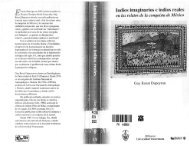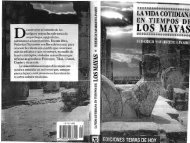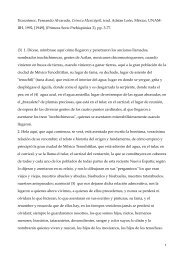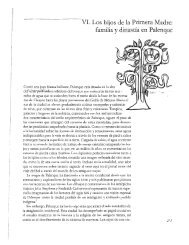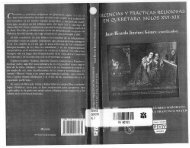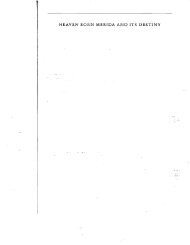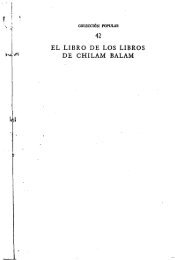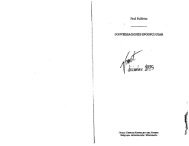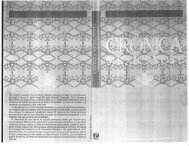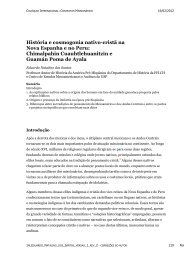1 - Histomesoamericana
1 - Histomesoamericana
1 - Histomesoamericana
Create successful ePaper yourself
Turn your PDF publications into a flip-book with our unique Google optimized e-Paper software.
i68 THE EIGHTEENTH CENTURY<br />
day, whenever they come, the<br />
monkey and turtle katuns and<br />
their departure. (4722)<br />
And this was the lord of the<br />
south, 3 Cauac 1 Pop in 1752 in<br />
katun 4 Ahau. There was a<br />
twenty-year cycle and then four<br />
more and Cauac returns. Then<br />
Kan speaks, making five days,<br />
U cuch num ya<br />
Tiolantac<br />
Ti u talel ti kin<br />
Licil u binil tz'acab kin<br />
C u talel e<br />
Ha li be oclis t u ba ob<br />
U maxil katun<br />
Coc ix u katunilob<br />
Oklem ix<br />
U u ichob.<br />
38. End of the Long Count<br />
(I8r) He x Ahau culh i*<br />
T u cuch hab ti nohol<br />
Oxil Cauac<br />
U hun te Pop<br />
T u habil<br />
Hi 1552 culh i<br />
Can Ahau katun<br />
T u hach kinil<br />
Hun hun kal hab u cuch ob<br />
Hun hun tul ti ob<br />
Tun cam ppel i e<br />
Ix ma kaba<br />
Licil u baxal ho ppel hab i<br />
Y etel Cauac bac ix<br />
Ti lie u cutal katun i e<br />
Kaan<br />
The burdens of suffering<br />
Will be recounted<br />
4715 That are coming at the time,<br />
As well as the future steps of days<br />
That are coming.<br />
However they will be brought<br />
together:<br />
The monkey katuns,<br />
4720 The turtle katuns,<br />
And the departure<br />
Of their faces.<br />
And that was the lord who was seated<br />
And bore the year in the south.<br />
4725 On the third Cauac<br />
On the first of Pop<br />
In the year<br />
1552 it may have been seated.<br />
4 Ahau was the katun<br />
4730 At that very time.<br />
Each twenty years were their burdens,<br />
Each and every one of them.<br />
Then there were four of them<br />
And they were without names,<br />
4735 As they played five years<br />
And Cauac was once again<br />
The one who was seating the katun,<br />
Kan<br />
4723. This is the earlier of the two texts in the Tizimin dealing with the<br />
Valladolid calendar. Written in 1752, it is a concise summary of the state of the<br />
Mayan calendar at that time. It acknowledges the supremacy of the Spanish año<br />
(albeit still without recognizing leap year), lists the tzol kin second, then the hab,<br />
and finally the katun of tuns—for sacrifice and divination. It leaves unstated the<br />
premise of the change, which was that in a year beginning 3 Cauac 1 Pop the<br />
name day of the katun fell on May 27,1752, the second day of the year: 4 Ahau<br />
2 Pop. Calculating correctly that extending the katun from twenty tuns to<br />
twenty-four habs would make this circumstance permanent, the priests decided<br />
to do so, even though it meant giving 4 Ahau a span of thirty-nine years. They<br />
continued to peg the Mayan new year to an arbitrary July 16 in the Christian<br />
calendar and to carry the leap year correction "in their heads."<br />
"1



